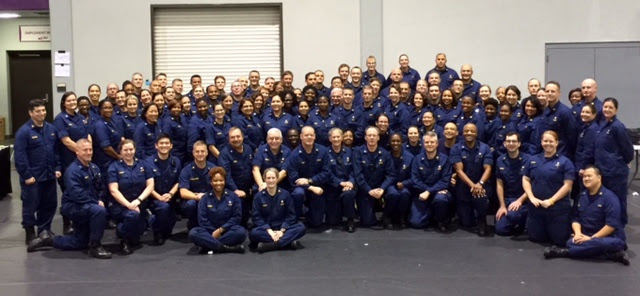The 2016 Louisiana Major Flooding: A Scientist Officer’s Preparation and Response
By LCDR Zewditu Demissie
In August 2016, the state of Louisiana was hit by a 1,000-year flood. Particularly hard hit by this natural disaster was the area of Baton Rouge. On August 14, 2016, RDF3 was activated to Baton Rouge to manage a medical special needs shelter at the Carl Maddox Track and Field House on the Louisiana State University campus. From August 16–29, 2016, RDF3 worked along with AL-3 (Alabama) and NM-1 (New Mexico) federal Disaster Medical Assistance Teams (DMATs) under a unified command structure to provide healthcare, logistical, and administrative support for the response.
As a member of RDF3, I was deployed to Baton Rouge as the Epidemiology Team Supervisor. The Epidemiology Team consisted of four officers serving on one of two 12-hour shifts; three served on the day shift and one served on the night shift. The team served a variety of functions. Regular duties included (1) collaborating with Medical Records staff to maintain a real-time medical special needs shelter occupant database, (2) distributing the medical special needs shelter surveillance report every 24 hours, (3) assisting Medical Services Branch with isolation and quarantine, and (4) providing occupational health services when needed. The Epidemiology Team would also assist other responders from RDF3 or DMATs when needed, such as assisting Medical Records with looking up patient information, and assisting Ancillary Services with staffing the front desk to the shelter and escorting visitors. The Epidemiology Team also helped by supporting a Tdap (tetanus, diphtheria, and pertussis) vaccination clinic that was implemented by the state, and patient discharge planning.
Working with Microsoft Excel was the Epidemiology Team’s most utilized skill during this deployment; however, several additional skills are critical for deployment. Resiliency and flexibility will help you during a two-week deployment, when there is little time off and your tasks may evolve rapidly and frequently. Additional general skills that apply across deployment roles include the ability to approach problems from a field perspective and the willingness to ask questions in new situations if you are asked to try new skills that are outside of your comfort area. Many officers interact with patients and partners; therefore, communication and interpersonal skills are also useful.
Deployment training for specific roles is typically just-in-time, meaning it is delivered when and where officers need it rather than far in advance. Officers on deployment teams should attend all team meetings and take any required team training. Prior to a deployment, it is essential to monitor emails carefully and attend phone pre-deployment briefings. It may be useful for officers on Tier 3 rosters to take advanced deployment training in preparation for response, as Tier 3 officers are often rostered along with Tier 1 and Tier 2 teams.
Tier 1 teams are deployable within 12 hours; this means that preparation is key. Officers on Tier 1 teams should have a “Go Bag” packed with at least two sets of their ODU. Boots should be broken in, but it may be useful to also bring moleskin or other blister prevention and treatment products. I encourage officers to have a week’s worth of uniform t-shirts, as this will help extend how long you can go before doing laundry. I invested in a nice deployment backpack that could hold essentials and items that I would need while in the shelter. Finding the right deployment backpack involved trial-and-error, so do not wait until you are on-call to find the right bag. I currently have a plastic tote that contains all of the items — toiletries, non-perishable snacks, medicine, gear, etc. — that I need while on deployment.
Before deployment, I was fortunate to have a scheduled one-on-one meeting with my duty station team lead. We were able to sit down and discuss where I was with my current projects and re-evaluate my expected due dates for different tasks. Upon my return, my branch was very happy to have me back at work. Being away for two weeks resulted in some quick turnaround times for certain projects, but the deployment experience was very rewarding and I am happy to have had the opportunity to serve with 102 other PHS officers from RDF3 and Tier 3, and our counterparts from AL-3 and NM-1.

RDF3 Team photo
Next Deployment Narrative Back to Deployment Narrative homepage